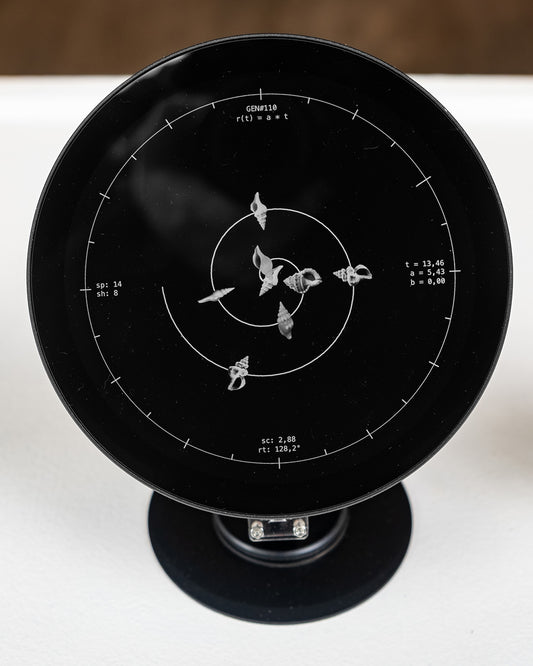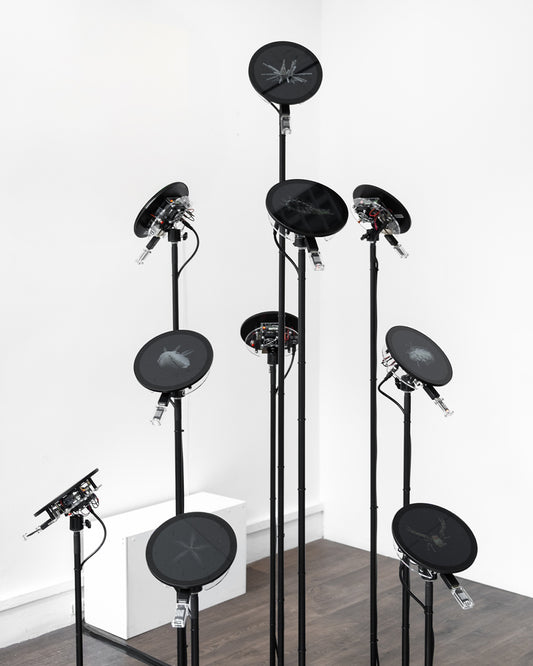from December 8, 2022 to January 7, 2023
with Olivier Bodini, Florence Cardenti, Julien Espagnon, Julien Gachadoat, Arnaud Pfeffer, Vidya-Kelie Juganaikloo, Soliman Lopez
The group exhibition MICRO/MACRO presents artistic approaches that are transversal between photography, programming, and automation of tools. It offers a vision of the world at different scales, the artists question the connections and the formal aspect that results from it. This form is embodied in matter; whether tangible or digital, it seems to belong to a familiar and complex organization.
The project “Sisyphe, un lendemain” was born out of a collaboration between Florence Cardenti, an artist who works in the field of photography and media exploration, and Julien Espagnon, who comes from a background in applied arts and creative programming. The artists mixed their disciplines and mediums, overlaying macroscopic photographs of rocks with generative drawings of mineral inspiration. In this collaborative exploration, the interpretation of rock form is either captured from reality or determined by code. Yet the programmed patterns appear as familiar as photographs indexed to the real.
The algorithmic forms are built on the model of the primary structure of crystals, which grows by randomly reproducing itself. The generative possibilities allow the creation of patterns close to mineral matter, which recall the entropy of natural elements.
The superposition of mediums and points of view offer a particularly attractive dimension to the works. The photomacrography brings this detailed vision, which allows a total immersion in the work. The combination of the photographic material and the precise and monochromatic line of the drawing are crossed in a fair balance.
Julien Gachadoat explores the possibilities of generative drawing by creating unique works produced by algorithms. Combining monochrome geometric elements and playing with spatial repetitions, he works on the emergence of abstract forms by introducing a part of unpredictability with the help of random number sequences. Developing his own creative tools from simple graphic rules, Julien Gachadoat uses the computer to navigate the field of possible patterns. These unique forms are frozen on paper with a plotter, creating a link between writing and code.
Olivier Bodini is a specialist in the theory of tilings and the random generation of combinatorial structures. He holds a thesis on Boltzmann generators, a mathematical principle that allows the definition of algorithms simulating the behavior of complex organizations. By diverting the use of the formal calculation software Maple, he gives an artistic form to visualizations of social connections on Twitter. This is followed by a production based on mathematical principles such as propagation equations and community search algorithms. By performing queries on a database of tweets, he organizes and models the data that form the traces of interactions. Grouped by color according to common interests and communities, he obtains complex graphs where each circle represents an individual while a link connects an exchange; thus formalizing influence networks.
Olivier Bodini explores aesthetic systems, seeking a balance between complexity and visual comprehensibility. He is particularly interested in the cognitive perception of works with a semantic, entropic richness. His compositions are formed of a multitude of information that could leave room for chaos. However, the richness of the spatial organization and the aesthetic value that results from it, seem to belong to the universal.
Soliman Lopez is a contemporary artist of Spanish origin. His career as an art historian and his Master's degree in art and communication have conditioned his artistic evolution towards a conceptual art, oriented on a technological research.
OLEA is a hybrid project involving blockchain technologies and biotechnologies. It consists in the creation of a new crypto-currency transcribed into a DNA sample, and transferred in physical form. For its implementation, Solimán López gathers a team of experts in biotechnology and genetics, in collaboration with Blockchain developers, and members of the Artist's Studio. They synthesize the crypto-currency using digital storage systems based on the genetic code, which allows information to be stored in DNA, and then transferred into olive oil molecules. OLEA integrates a conceptual look at the economic revolution linked to the advent of crypto-currencies, by transposing them through science into a natural element, and thus connecting them to a primary product of the earth. This materialization into a tangible product from agriculture, could become a new way to consider economic and monetary exchanges.
The project takes various forms; sculptural, audiovisual, installations and NFT videos. The Olea Genesis video series, symbolically represents the synthesis of the OLEA project, through the staging of a drop of olive oil in virtual landscapes.
The video Olea Genesis, Space 1/10 is presented at the MICRO/MACRO exhibition via Infinite Object technology; an LCD screen that contains the digital work linked to an NFT via a unique QR code.
Vidya-Kelie Juganaikloo is a French-Mauritian transmedia artist, born in France, living and working in Paris. She uses technology to capture traces of exchanges and connections, capturing sensitive phenomena to offer them a symbolic representation. She thus gives a tangible aspect to impalpable links, elusive information, linked to human or organizational links. The artist redefines the relationship of scale of our exchanges linked to the use of technologies in our everyday life, by linking them to the elements, as in her series SUN, with the sun. In this series she gives a vision of connections to global space and from data collected on Instagram. Every second, people who are connected to the social network Instagram post new photos with the hashtag #SUN. On a map, the hashtag's activity draws an abstract and infinite yellow line that the artist feeds with a narrative she generates with artificial intelligence.
SUN is a work that lies between an emotional map and a real-time data repository. The photographs posted on the wire reveal the trajectories of a digital sun and archive in a poetic way the contemporary sky of thousands of digital "Suns".
Vidya-Kelie deploys her concepts on protean supports, they are embodied in the digital as in the tangible. The SUN series, whose origin is digital, has been declined by the artist in paper print, dibond and for the first time presented in mirror on plexiglass.
Arnaud Pfeffer is an industrial designer and generative artist born in 1992, he lives and works in Paris. His practice consists in exploring the link between the physical and the digital, particularly by using drawing machines, like plotters. It is this confrontation of a perfect mechanical movement with the materiality left by the trace of the tool that interests him particularly. In this process the graphic accident and the unforeseen are all the more visible as the tracing is delegated to a movement of an inhuman precision. To maintain this resonance, he designs his own graphic tools and diverts existing machines. From his technical engineering training, he has developed an affinity for industrial processes and rapid prototyping tools used in industrial creation. This has also led to his approach to design, and his work around the vocabulary of the tool.
The "Automated Suminagashi" series is inspired by the Japanese technique known as "flowing ink", which consists of creating marbling patterns with ink.
By placing drops of ink on the surface of water, then disturbing the material with a tracer, he creates patterns that he then deposits on the paper. This series is an extension of the artist's experimentation with robotic tools; the graphic games obtained by automated tracings and the play with mediums. By capturing emerging patterns through the movements of water and ink, he captures the random and natural process of form generation.
Arnaud Pfeffer's approach is a balance between control of the manufacturing process determined by robotic intervention, and the imponderable linked to a more artisanal approach. This exploration between physical and digital is directly linked to his initial training in industrial design; particularly the fields of research related to the automation of tools and the research of materials.



